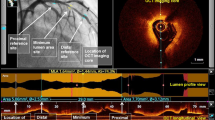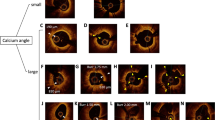Abstract
Percutaneous coronary intervention (PCI) for heavily calcified lesions is challenging because these lesions are resistant to balloon dilatation and stenting. Lacrosse non-slip element (NSE) may have the potential to dilate heavily calcified lesions. We aimed to investigate predictors of successful lesion modification using Lacrosse NSE angioplasty via optical coherence tomography (OCT)-guided PCI. We investigated 32 patients with severe target lesion calcification treated with OCT-guided PCI. Successful lesion modification was defined as the complete fracture of calcification after Lacrosse NSE angioplasty. Before PCI, 172 segments with calcification were identified. After pre-dilatation using Lacrosse NSE, successful lesion modification was achieved in 117 segments (68.0%). Calcification was significantly thinner in successfully disrupted segments than in non-disrupted segments (p < 0.001). Calcification angle tended to be larger in disrupted than in non-disrupted segments (p = 0.08). Convex types were less frequently observed in disrupted than in non-disrupted segments (p < 0.001). At minimal lumen area sites, 26 segments (81.3%) were successfully modified. Similar to the overall results, the disrupted group had significantly thinner calcification than the non-disrupted group (p < 0.001). The angle of the calcified plaque was similar between the 2 groups (p = 0.39). Convex-type calcifications were less frequently observed in the disrupted group than in the non-disrupted group (p = 0.05). Receiver-operating characteristic curve analysis showed that calcification thickness < 565 μm was the best predictor of completely disrupted calcification. The thickness and shape of calcifications were predictors of successful lesion modification after Lacrosse NSE angioplasty.



Similar content being viewed by others
References
Park DW, Park SW, Park KH, Lee BK, Kim YH, Lee CW, et al. Frequency of and risk factors for stent thrombosis after drug-eluting stent implantation during long-term follow-up. Am J Cardiol. 2006;98:352–6.
Song HG, Kang SJ, Ahn JM, Kim WJ, Lee JY, Park DW, et al. Intravascular ultrasound assessment of optimal stent area to prevent in-stent restenosis after zotarolimus-, everolimus-, and sirolimus-eluting stent implantation. Catheter Cardiovasc Interv. 2014;83:873–8.
Barath P, Fishbein MC, Vari S, Forrester JS. Cutting balloon: a novel approach to percutaneous angioplasty. Am J Cardiol. 1991;68:1249–52.
de Ribamar Costa J, Jr Mintz GS, Carlier SG, Mehran R, Teirstein P, Sano K, et al. Nonrandomized comparison of coronary stenting under intravascular ultrasound guidance of direct stenting without predilation versus conventional predilation with a semi-compliant balloon versus predilation with a new scoring balloon. Am J Cardiol. 2007;100:812–7.
Ashida K, Hayase T, Shinmura T. Efficacy of Lacrosse NSE using the “Leopard-Crawl” technique on severely calcified lesions. J Invasive Cardiol. 2013;25:555–64.
Yabushita H, Bouma BE, Houser SL, Aretz HT, Jang IK, Schlendorf KH, et al. Characterization of human atherosclerosis by optical coherence tomography. Circulation. 2002;106:1640–5.
Kume T, Okura H, Kawamoto T, Akasaka T, Toyota E, Watanabe N, et al. Relationship between coronary remodeling and plaque characterization in patients without clinical evidence of coronary artery disease. Atherosclerosis. 2008;197:799–805.
Kume T, Okura H, Kawamoto T, Yamada R, Miyamoto Y, Hayashida A, et al. Assessment of the coronary calcification by optical coherence tomography. EuroIntervention. 2011;6:768–72.
Miyamoto Y, Okura H, Kume T, Kawamoto T, Neishi Y, Hayashida A, et al. Plaque characteristics of thin-cap fibroatheroma evaluated by OCT and IVUS. JACC Cardiovasc Imaging. 2011;4:638–46.
Kobayashi Y, Okura H, Kume T, Yamada R, Kobayashi Y, Fukuhara K, et al. Impact of target lesion coronary calcification on stent expansion. Circ J. 2014;78:2209–14.
von Birgelen C, Mintz GS, Böse D, Baumgart D, Haude M, Wieneke H, et al. Impact of moderate lesion calcium on mechanisms of coronary stenting as assessed with three-dimensional intravascular ultrasound in vivo. Am J Cardiol. 2003;92:5–10.
Hoffmann R, Mintz GS, Popma JJ, Satler LF, Kent KM, Pichard AD, et al. Treatment of calcified coronary lesions with Palmaz–Schatz stents. An intravascular ultrasound study. Eur Heart J. 1998;19:1224–31.
Vavuranakis M, Toutouzas K, Stefanadis C, Chrishou C, Markou D, Toutouzas P. Stent deployment in calcified lesions: can we overcome calcific restraint with high-pressure balloon inflations? Catheter Cardiovasc Interv. 2001;52:164–72.
Kume T, Waseda K, Ako J, Sakata K, Yamasaki M, Shimohama T, et al. Intravascular ultrasound assessment of postprocedural incomplete stent apposition. J Invasive Cardiol. 2012;24:13–6.
Sonoda S, Morino Y, Ako J. Impact of final stent dimensions on long-term results following sirolimus-eluting stent implantation: serial intravascular ultrasound analysis from the SIRIUS trial. J Am Coll Cardiol. 2004;43:1959–63.
Fujii K, Mintz GS, Kobayashi Y, Carlier SG, Takebayashi H, Yasuda T, et al. Contribution of stent underexpansion to recurrence after sirolimus-eluting stent implantation for in-stent restenosis. Circulation. 2004;109:1085–8.
Doi H, Maehara A, Mintz GS, Yu A, Wang H, Mandinov L, et al. Impact of post-intervention minimal stent area on 9-month follow-up patency of paclitaxel-eluting stents: an integrated intravascular ultrasound analysis from the TAXUS IV, V, VI and TAXUS ATLAS workhorse, long lesion, and direct stent trials. JACC Cardiovasc Interv. 2009;2:269–75.
Uren NG, Schwarzacher SP, Metz JA, Lee DP, Honda Y, Yeung AC, et al. Predictors and outcomes of stent thrombosis: an intravascular ultrasound registry. Eur Heart J. 2002;23:124–32.
Fujimoto H, Nakamura M, Yokoi H. Impact of calcification on the long-term outcomes of sirolimus-eluting stent implantation: subanalysis of the Cypher Post-Marketing Surveillance Registry. Circ J. 2012;76:57–64.
Huang BT, Huang FY, Zuo ZL, Liu W, Huang KS, Liao YB, et al. Target lesion calcification and risk of adverse outcomes in patients with drug-eluting stents: a meta-analysis. Herz. 2015;40:1097–106.
Kubo T, Shimamura K, Ino Y, Yamaguchi T, Matsuo Y, Shiono Y, et al. Superficial calcium fracture after PCI as assessed by OCT. JACC Cardiovasc Imaging. 2015;8:1228–9.
Kawase Y, Saito N, Watanabe S, Bao B, Yamamoto E, Watanabe H, et al. Utility of a scoring balloon for a severely calcified lesion: bench test and finite element analysis. Cardiovasc Interv Ther. 2014;29:134–9.
Kang WC, Ahn TH, Han SH, Shin EK. Successful management of a resistant, focal calcified lesion following direct coronary stenting with a cutting balloon. J Invasive Cardiol. 2004;16:725–6.
Auer J, Maurer E, Berent R, Mayr H, Punzengruber C, Weber T, et al. Clinical and angiographic outcome after cutting balloon angioplasty. J Interv Cardiol. 2003;16:15–21.
Hendry C, Fraser D, Eichhofer J, Mamas MA, Fath-Ordoubadi F, El-Omar M, et al. Coronary perforation in the drug-eluting stent era: incidence, risk factors, management and outcome: the UK experience. EuroIntervention. 2012;8:79–86.
Im E, Kim BK, Ko YG, Shin DH, Kim JS, Choi D, et al. Incidences, predictors, and clinical outcomes of acute and late stent malapposition detected by optical coherence tomography after drug-eluting stent implantation. Circ Cardiovasc Interv. 2014;7:88–96.
Huisman J, van der Heijden LC, Kok MM, Danse PW, Jessurun GA, Stoel MG, et al. Impact of severe lesion calcification on clinical outcome of patients with stable angina, treated with newer generation permanent polymer-coated drug-eluting stents: a patient-level pooled analysis from TWENTE and DUTCH PEERS (TWENTE II). Am Heart J. 2016;175:121–9.
Author information
Authors and Affiliations
Corresponding author
Ethics declarations
Conflict of interest
The authors declare that they have no conflict of interest.
Research involving human participants and/or animals
All procedures performed in this study involving human participants were in accordance with the ethical standards of the institutional and/or national research committee and with the 1964 Helsinki declaration and its later amendments or comparable ethical standards. For this type of study formal consent is not required.
Informed consent
Informed consent was obtained from all individual participants included in the study.
Rights and permissions
About this article
Cite this article
Sugawara, Y., Ueda, T., Soeda, T. et al. Plaque modification of severely calcified coronary lesions by scoring balloon angioplasty using Lacrosse non-slip element: insights from an optical coherence tomography evaluation. Cardiovasc Interv and Ther 34, 242–248 (2019). https://doi.org/10.1007/s12928-018-0553-6
Received:
Accepted:
Published:
Issue Date:
DOI: https://doi.org/10.1007/s12928-018-0553-6




